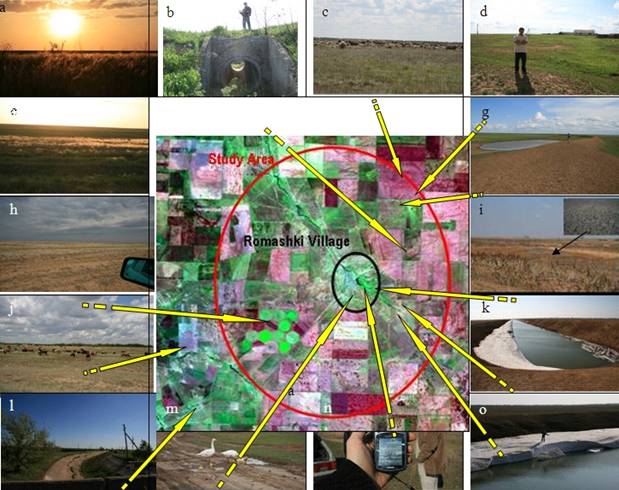Romanashki village
The Romashki of Romashki Village, former Shtrasburg village, (experimental plot, Fig. 8) located 32 km in north-westerly direction from the town of Pallasovka, is 153 ha. The population is about 1200 people, 286 personal subsidiary plots. This village was founded by German colonists under the epoch of Catherine the Great (1729-1796) with around 2000 people living there in the XIX and XX centuries.
The collective farm of Romashki village was established in 1944 and has around 33,300 ha of land (21,300 ha of arable lands). The main products of this farm are meat,wool (sheep, Fig. 11. c, d), milk (Fig. 11j) and cereals. This farm is one of two biggest sheep farms in the Pallasovsky district. Cereals, mustard and rye are the main crops grown. However, this requires an adequate land territory and appropriate management that is not always accomplished. Due to overgrazing soil erosion occurs.
In the XIX century, German settlers developed a huge melt-water retention system made of earth, to be used for crop growing. At present, these systems are degraded and don't provide a full service (Fig. 11 b). Constructed during the second part of the previous century the irrigation system was considered as not efficient for the prevailing market economy due to the high price for supplied water and was therefore abandoned (Fig. 11 h). As a consequence the pumping of canal water was stopped (Fig. 11 l) that blocked also and water supply for household use including gardening. Water ponds of about 1 km3 capacity that were constructed for local surface water retention and for collective use for recreation and growing of domestic тatatorial bird, fish breeding and watering livestock (Fig. 11 m) are almost empty (Fig. 11 g, i) due to increased surface water infiltration rate fed these ponds. A special groundwater reservoir (Fig. 11 k, o) constructed with explosives during Soviet time as watering place for livestock was redesigned for mixing fresh surface water and mineralized groundwater (about 7-15 g/l). During the last ten years it had not the capacity to provide enough water during all time needed, due to decreasing groundwater table (about 2 m).

Fig. 11: Study plot at the territory of Romashki village. (a) Sun rise in steppe. (b) Demolished weir in the levee of water detention pond designed for snow retention and harvest. (c) Sheep breeding. (d) Local farmer dealing with sheep breeding. (e) Virgin steppe. (f) Study site territory oat Romashki village. (g) Artificial water reservoir used as water place for cattle. (h) Abandoned land at ruined irrigation system. (i) Practically empty artificial surface water detention pool. (j) Cows on natural pasture. (k) (o) Artificial ground water reservoir. (l) Empty irrigation channel. (m) Geese at side of road. (n) Administration heads of Romashki village during study site assessment.
Some of the mentioned water resource degradation processes can be explained by a change of seasonal patterns in the local climate (i.e. rain during late autumn instead of snow that diminishes the depth of frozen soil), long droughts, and consequences of the destruction of irrigation system.
During summer time water for domestic use is supplied in a big car-pulled cistern. In such conditions local people are very limited in the use of their garden for vegetable growing.
Degradation of land and water resources affects peoples' income by decreasing food production (yields become lower and lands are abandoned because of salinization). The young generation is leaving rural areas due to the low quality of life and the perceived possibilities to find a better income in the urban areas. Lack of information about sustainable land management, climate instability and weak institutional support as well as low financial support from governmental organizations make the life of the people in this region difficult.
The main income of the stakeholders in the study site (Romashki) is agricultural production from their garden plots (fruits and vegetables), and breeding cattle (sheep and cows). There is a big agricultural conglomeration farm "Romashkovsky". A number of people are working in this farm and their salary depends on its production.